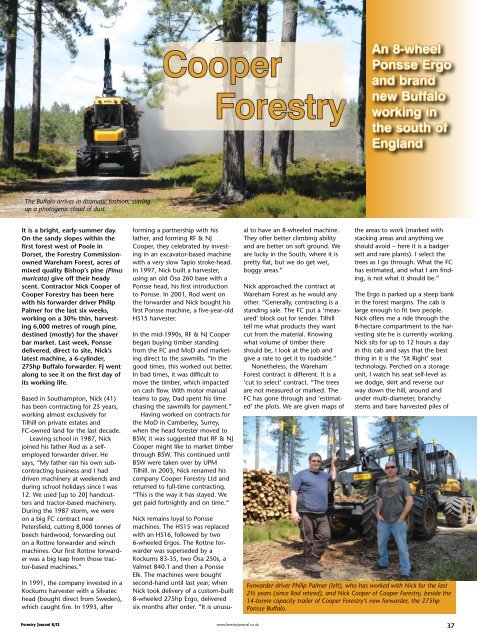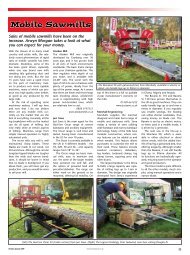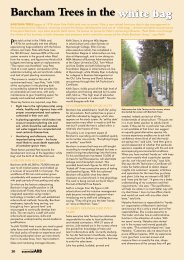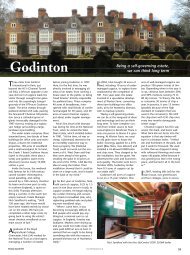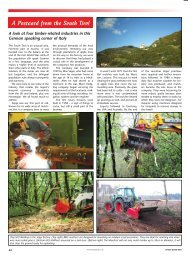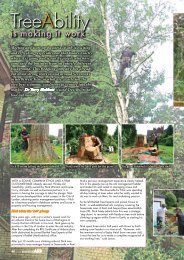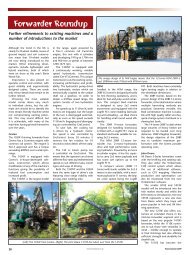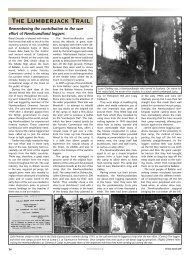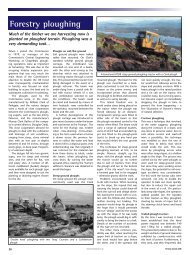Cooper Forestry - Forestry Journal
Cooper Forestry - Forestry Journal
Cooper Forestry - Forestry Journal
- No tags were found...
You also want an ePaper? Increase the reach of your titles
YUMPU automatically turns print PDFs into web optimized ePapers that Google loves.
<strong>Cooper</strong><strong>Forestry</strong>An 8-wheelPonsse Ergoand brandnew Buffaloworking inthe south ofEnglandThe Buffalo arrives in dramatic fashion, stirringup a photogenic cloud of dust.It is a bright, early-summer day.On the sandy slopes within thefirst forest west of Poole inDorset, the <strong>Forestry</strong> CommissionownedWareham Forest, acres ofmixed quality Bishop’s pine (Pinusmuricata) give off their headyscent. Contractor Nick <strong>Cooper</strong> of<strong>Cooper</strong> <strong>Forestry</strong> has been herewith his forwarder driver PhilipPalmer for the last six weeks,working on a 30% thin, harvesting6,000 metres of rough pine,destined (mostly) for the shaverbar market. Last week, Ponssedelivered, direct to site, Nick’slatest machine, a 6-cylinder,275hp Buffalo forwarder. FJ wentalong to see it on the first day ofits working life.Based in Southampton, Nick (41)has been contracting for 25 years,working almost exclusively forTilhill on private estates andFC-owned land for the last decade.Leaving school in 1987, Nickjoined his father Rod as a selfemployedforwarder driver. Hesays, “My father ran his own subcontractingbusiness and I haddriven machinery at weekends andduring school holidays since I was12. We used [up to 20] handcuttersand tractor-based machinery.During the 1987 storm, we wereon a big FC contract nearPetersfield, cutting 8,000 tonnes ofbeech hardwood, forwarding outon a Rottne forwarder and winchmachines. Our first Rottne forwarderwas a big leap from those tractor-basedmachines.”In 1991, the company invested in aKockums harvester with a Silvatechead (bought direct from Sweden),which caught fire. In 1993, afterforming a partnership with hisfather, and forming RF & NJ<strong>Cooper</strong>, they celebrated by investingin an excavator-based machinewith a very slow Tapio stroke-head.In 1997, Nick built a harvester,using an old Ösa 260 base with aPonsse head, his first introductionto Ponsse. In 2001, Rod went onthe forwarder and Nick bought hisfirst Ponsse machine, a five-year-oldHS15 harvester.In the mid-1990s, RF & NJ <strong>Cooper</strong>began buying timber standingfrom the FC and MoD and marketingdirect to the sawmills. “In thegood times, this worked out better.In bad times, it was difficult tomove the timber, which impactedon cash flow. With motor manualteams to pay, Dad spent his timechasing the sawmills for payment.”Having worked on contracts forthe MoD in Camberley, Surrey,when the head forester moved toBSW, it was suggested that RF & NJ<strong>Cooper</strong> might like to market timberthrough BSW. This continued untilBSW were taken over by UPMTilhill. In 2003, Nick renamed hiscompany <strong>Cooper</strong> <strong>Forestry</strong> Ltd andreturned to full-time contracting.“This is the way it has stayed. Weget paid fortnightly and on time.“Nick remains loyal to Ponssemachines. The HS15 was replacedwith an HS16, followed by two6-wheeled Ergos. The Rottne forwarderwas superseded by aKockums 83-35, two Ösa 250s, aValmet 840.1 and then a PonsseElk. The machines were boughtsecond-hand until last year, whenNick took delivery of a custom-built8-wheeled 275hp Ergo, deliveredsix months after order. “It is unusualto have an 8-wheeled machine.They offer better climbing abilityand are better on soft ground. Weare lucky in the South, where it ispretty flat, but we do get wet,boggy areas.”Nick approached the contract atWareham Forest as he would anyother. “Generally, contracting is astanding sale. The FC put a ‘measured’block out for tender. Tilhilltell me what products they wantcut from the material. Knowingwhat volume of timber thereshould be, I look at the job andgive a rate to get it to roadside.”Nonetheless, the WarehamForest contract is different. It is a‘cut to select’ contract. “The treesare not measured or marked. TheFC has gone through and ‘estimated’the plots. We are given maps ofthe areas to work (marked withstacking areas and anything weshould avoid – here it is a badgersett and rare plants). I select thetrees as I go through. What the FChas estimated, and what I am finding,is not what it should be.”The Ergo is parked up a steep bankin the forest margins. The cab islarge enough to fit two people.Nick offers me a ride through the8-hectare compartment to the harvestingsite he is currently working.Nick sits for up to 12 hours a dayin this cab and says that the bestthing in it is the ‘Sit Right’ seattechnology. Perched on a storageunit, I watch his seat self-level aswe dodge, skirt and reverse ourway down the hill, around andunder multi-diameter, branchystems and bare harvested piles ofForwarder driver Philip Palmer (left), who has worked with Nick for the last2½ years (since Rod retired), and Nick <strong>Cooper</strong> of <strong>Cooper</strong> <strong>Forestry</strong>, beside the14-tonne capacity trailer of <strong>Cooper</strong> <strong>Forestry</strong>’s new forwarder, the 275hpPonsse Buffalo.<strong>Forestry</strong> <strong>Journal</strong> 8/12 www.forestryjournal.co.uk37
80-year-old Bishop’s pine.Before starting work on any harvestingcontract, the timber recoverysizes are entered into the Opti5 computer, which prioritises themost important products by price.The program ‘optimises’ each tree,cutting the best product from eachstem to maximise value.To demonstrate, Nick harvests astem. The cab rocks. Crown fightsneighbouring crown. Nick strugglesto lay the pole flat. By the timehe has said, “This is a problemhere; the trees are so rubbery youcannot get them on the ground,”the Ergo has cut, colour-markedand laid two 2.9-metre bars intopiles for chipwood, and a third forfencing.We inspect the Ergo’s cutting head.Nick says, “The Ergo has a big oilflow and big pumps. Whereascompetitor machines have onepump to the crane and head, thePonsse has two: a 145cc pump tothe C4 crane, and a 190cc pumpto the head. I chose external feedand return hoses to the head. Therest are inside the boom.”For its size, the H7 (70cm) headis powerful. “At 30 kilonewtons,the feeding force is phenomenal.The machine cuts a wide range ofmaterial; from tiny 0.07-metre thinnings,right up to the 5.5-metresticks (1.5-metre diameter) of Sitkaspruce cut at our last job inCheddar. In this small, roughbranchy pine, I am cutting 15 to20 metres an hour. In clean timber,you can get up to 60 to 70 metresan hour.“The knives should last fiveyears, but do wear down. I sharpenthem once a week with a lighttouch, using a grinder and flapdisk, which gives a good shiny finish.The feed rollers are longtoothed,because in the South wehave deep bark and we need theextra traction.”Under Ponsse’s 12-month warranty,the machine is serviced at200 and 1,200 hours. Most partson the Ergo needing regular maintenanceare easily accessible. Theonly problem has been a frontknife snapping clean off. Ponssereplaced it the next day.Since taking delivery of the Ergo,<strong>Cooper</strong> <strong>Forestry</strong> has done well. Lastyear, profits were up by 20%. “Insmall material, it takes a long timefor the Ergo to cut a tonne of timber.In the bigger material, productivityincreases by 20%. Last year Icut 35,000 metres in 1,700 hours.“On this site, the FC cut [directproduction] the big material, thenparcelled up the smaller, uneconomicaltimber. I gave a price forthis job at a certain tree size. In myopinion, the measure that the FCsay is here is not. It is way smallerthan it should be and I am not cuttingenough timber each day.Production is down 40%. Afterexpenses, it is costing me £1,000 aweek to come to work. It is hard toargue with what the Ergo’s computersays has been cut, but the FCare trying to. I have a meeting withTilhill and the FC forester at 4pm[to try and resolve the issue].”Parking the Ergo back at the forestedge, Nick says that although helikes to work within a 70-mile radiusof home, the downside of contractingin southern England is thatthere are no long-term contracts.For three months of the year, Nickstays in motels and Philip Palmer,who has worked with Nick as a forwarderdriver for the last 2½ years(since Rod retired), stays in hisBailey Olympus 530-4 ‘caravan’when <strong>Cooper</strong> <strong>Forestry</strong>’s machineryis low-loaded as far away asRedditch and Devon. Their lastcontract was in Cheddar. Theirnext project, in Marlborough, isactually four contracts, three forsoftwood and one for cutting2,000 metres of beech hardwood.Nick remains loyal to Ponssebecause of their machinery’s reliabilityand build quality. LastChristmas, together with othercontractors, he went to Finland tolook around the Ponsse factory.“We went into the forest where aBuffalo was working. Having a goon it convinced me it was the rightmachine to replace our 4-cylinder13-tonne, 175hp Elk forwarder.”Ordered after Christmas, the14-tonne 275hp Buffalo, with a10-metre reach (and hose-workhoused inside the boom) was deliveredin just six months. Although amedium-sized machine, the Buffalois comparable to some competitors’‘big’ machines.The 8-wheel Ergo stripping a stem of Bishop’s pine.The Ponsse Ergo harvester and the H7 (70cm) head is powerful. “The feedingforce is phenomenal. In this small, rough, branchy pine, I am cutting 15to 20 metres an hour. In clean timber, you can get up to 60 to 70 metresan hour.“We drive the mile between harvestingand forwarding operations inNick’s Toyota Hilux. Philip spentthe best part of yesterday tweaking‘parts’, like moving the ‘too-close’bolster backwards so that longerlengthlogs loads would balance.This means that Philip is running aweek and half behind Nick and wespot the Buffalo, on its first full dayof work, making the first of threepasses through this steeper part ofthe forest. The first log load is destinedfor Bedmax (chip), the secondfor shaver bars (Mendip) andthe third for fencing materials. Wereturn to the log pile and wait. TheBuffalo arrives in dramatic fashion,stirring up a photogenic cloud ofdust.Logs unloaded, Philip steps downfrom the cab and says, “Ponssedelivered the Buffalo to the sitestraight from Hull docks. TheyPDI’d it, set up the crane, installedthe radio and bar signature system,and the Buffalo was good to go.This machine has an extra 100hpto the wheels in a 6-cylinderengine. It goes well up hills. Theback-end is the same size as theElk’s, with a slightly larger loadcapacity. Nick had the exhaust pipeshortened to stop it snagging inthe trees. The crane is smoother.With an internal hose run, I am notworried about pulling the metalpipes off. The larger 0.35 grab canpick up an extra 15%, making adifference, especially in the smallerInside the cab of Nick’s Ergo harvester,with the Opti 5 system onthe computer screen, showinglength, diameter and optimisation.38www.forestryjournal.co.uk<strong>Forestry</strong> <strong>Journal</strong> 8/12
timber. Unloading is quicker.”Nick listens to the engine. “Therevs are set at 1200 for loading,which is quite low. I think it needssetting at 1250 or 1300, because Ican hear it pulling down the powerof the engine.” Philip nods inagreement.Philip says that the Buffalo hasbeen well though out. “Access formaintenance was a battle before;there was no room beneath theElk’s cab. This one has plenty ofroom underneath it and the interiorhas been updated with Ponssecontrols.“The Buffalo is massively overengineeredfor a forwarder. Thecentre joint is a lot stronger thanon older models. Now we haveheavy-duty stabiliser rams, whichstop the cab jiggling around andsmooth out the ride.” Philip doesnot have ‘Sit Right’ technology,preferring to operate, “By the seatof my pants.”Philip needs another couple ofdays getting used to the Buffaloand speeds up again. Nick, in themeantime, has a meeting to go to.Having spent £295,000 on theErgo and £200,000 on the Buffalo,Nick expects to keep bothmachines for fiveyears beforeupgrading again.“At four to fiveyears old you startto get problemswith machines. Itthen becomes abalance; whetherto pay money infinance, or inbreakdowns andrepair costs. As acontractor, if mymachine is notavailable, I am notavailable and itdoes not lookgood to my client.We work hard. Weget a job, and weget on with thejob. It is far better to get a freshmachine and avoid the downtime.”Addendum: After another on-sitemeeting with the FC, the matterthat Nick had hoped to resolve isstill (to date) unresolved. He says,“I decided to move the machinesoff this site and to cut my losses.”<strong>Cooper</strong> <strong>Forestry</strong> 07774 700312Carolyne Locher<strong>Cooper</strong> <strong>Forestry</strong>’s new forwarder,the 14-tonne, 275hp Buffalo, witha 10-metre reach loader (hoseshoused inside the boom) unloadingshaver bars. Nick had the exhaustpipe shortened so that it would notcatch on branches when in the forest.The new computer system is not atthe front of the cab as it is in theErgo harvester. In the Buffalo, it isto one side. Philip can see it whendriving either forwards or backwards.“This is a bigger monitorwith more information on it.”<strong>Forestry</strong> <strong>Journal</strong> 8/12 www.forestryjournal.co.uk39


